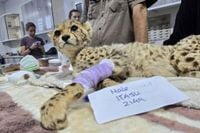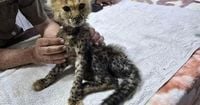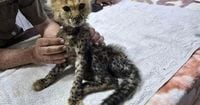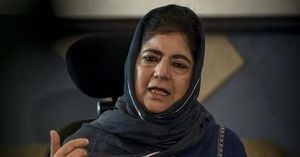Ten cheetah cubs, once destined for the shadowy corridors of the international wildlife trade, are now resting in the care of conservationists in Somaliland after a dramatic rescue operation on August 14, 2025. The cubs, all held in captivity since birth and suffering from the effects of months of neglect, were intercepted in the northern Sallahley District of this breakaway region of Somalia, a place increasingly recognized as a key battleground in the fight against illegal wildlife trafficking.
According to the Associated Press, the operation, which resulted in the arrest of two individuals found in possession of the cubs, marks another significant intervention by local authorities and conservation groups. The Cheetah Conservation Fund (CCF), an internationally respected organization led by founder Laurie Marker, is now overseeing the cubs' recovery. Marker described the animals’ dire state upon arrival: one 8-month-old cub was “unable to walk after being tied up for six months,” while a 5-month-old was “very malnourished (a bag of bones), with sores all over her body and full of botfly maggots which are under the skin.”
Despite these harrowing details, Marker reported on August 20 that all ten cubs were in stable condition. The road to recovery, however, is a delicate one. “But with cubs like this, we need to start them on food slowly due to refeeding syndrome, similar to people in starvation,” she explained, referencing the potentially life-threatening complications that can arise when malnourished animals are reintroduced to food too quickly.
The cubs’ ordeal is, sadly, part of a much larger pattern. Somaliland has become a major transit hub for the illegal wildlife trade, with hundreds of cheetahs and leopards from the Horn of Africa smuggled through the Gulf of Aden to meet the soaring demand for exotic pets in Gulf countries. According to BBC reporting, conservationists have repeatedly sounded the alarm about the devastating impact this trade is having on already fragile ecosystems in the region.
The ten rescued cubs now join a group of 109 others previously saved from similar fates in recent operations. Abdinasir Hussein Said, Director of Somaliland’s Environment Ministry, emphasized the gravity of the situation in remarks to journalists. He noted that possession of wildlife is illegal in Somaliland, where police frequently crack down on suspected traders in an effort to stem the tide of trafficking. “We encourage the people of Somaliland to protect wildlife in their natural habitats, as their best interests lie there,” Hussein said. He continued, “We can imagine the distress of a mother being separated from her young. These animals are currently suffering due to being separated from their mothers, which may lead to the mothers experiencing stress and potentially dying. Once again, we emphasize the importance of protecting wildlife in their habitats.”
The emotional toll on both the animals and their mothers is not lost on the authorities or the conservationists involved. The trauma of separation, compounded by the physical effects of captivity, leaves lasting scars. Hussein’s appeal to the public is both practical and poignant, recognizing that the fight against wildlife trafficking requires community vigilance as much as law enforcement. The authorities have urged citizens to report any suspected wildlife trade activities, hoping that greater awareness and participation can help protect the region’s iconic species.
Somaliland’s position as a key node in the illicit trade is, in part, a consequence of geography. Its proximity to the Gulf of Aden makes it a convenient staging ground for traffickers moving animals out of the Horn of Africa and into lucrative markets abroad. The demand for cheetahs and leopards as status-symbol pets in Gulf countries has driven prices up and created powerful incentives for smugglers, often at the expense of local wildlife populations and the communities that depend on them.
Conservationists warn that the removal of apex predators like cheetahs and leopards from their natural habitats can have cascading effects throughout the ecosystem. These animals play a critical role in maintaining the balance of their environments, and their loss can lead to overpopulation of prey species, habitat degradation, and a host of other unintended consequences. According to the CCF, the illegal trade is not just a threat to individual animals but to the survival of entire species in the wild.
The rescue of these ten cubs, while a cause for celebration, is also a sobering reminder of the scale of the problem. The fact that over 100 cubs have been rescued in recent years speaks to both the persistence of traffickers and the determination of those working to stop them. Each successful intervention is a testament to the dedication of local authorities, international conservation groups, and concerned citizens, but it also highlights the need for continued vigilance and cooperation.
Efforts to combat the illegal wildlife trade in Somaliland have been bolstered by increased crackdowns on traders and the implementation of stricter laws prohibiting the possession of wildlife. Yet, as the recent rescue demonstrates, traffickers continue to find ways to exploit loopholes and evade detection. The authorities’ call for public involvement is an acknowledgment that lasting change will require more than just policing—it will demand a cultural shift toward valuing and protecting the region’s natural heritage.
For the ten cubs now recovering under the watchful eyes of the CCF, the future is uncertain but hopeful. Their journey from captivity to sanctuary is a testament to the power of collective action and the resilience of those who refuse to let these magnificent creatures disappear. As conservationists and officials alike have made clear, the stakes could not be higher—not just for the cubs, but for the ecosystems and communities that depend on a thriving, balanced natural world.
While the illegal wildlife trade remains a daunting challenge, the events in Somaliland offer a glimmer of hope that with determination, compassion, and cooperation, it is possible to turn the tide. The story of these cheetah cubs is far from over, but for now, they are safe—and that is something worth celebrating.






